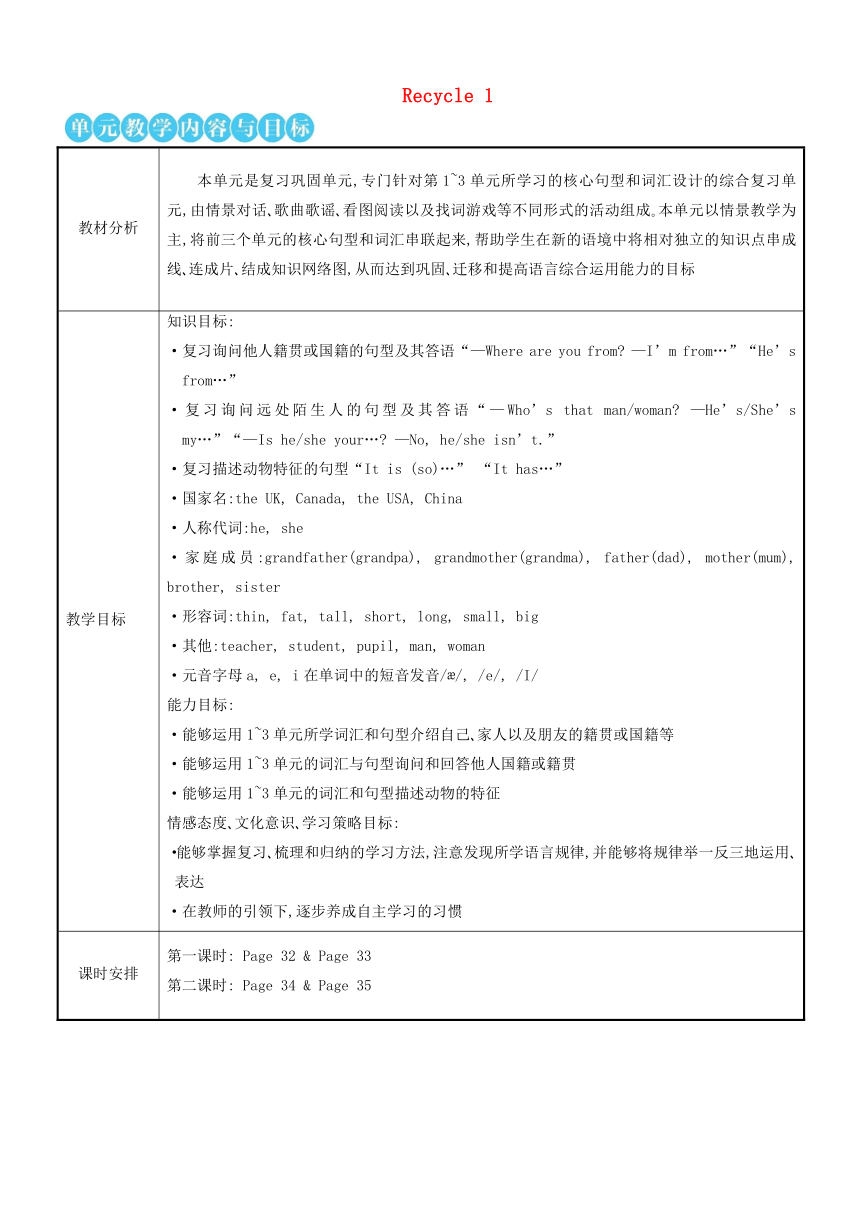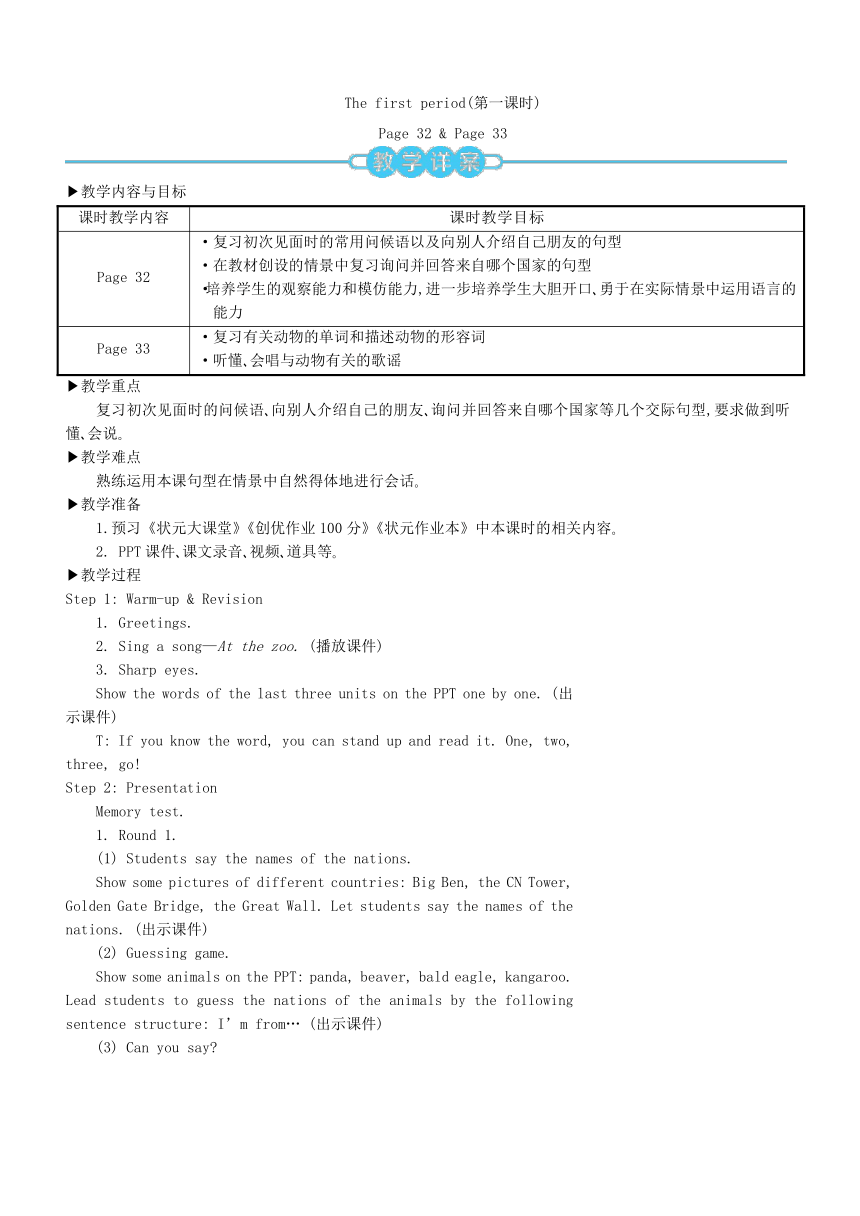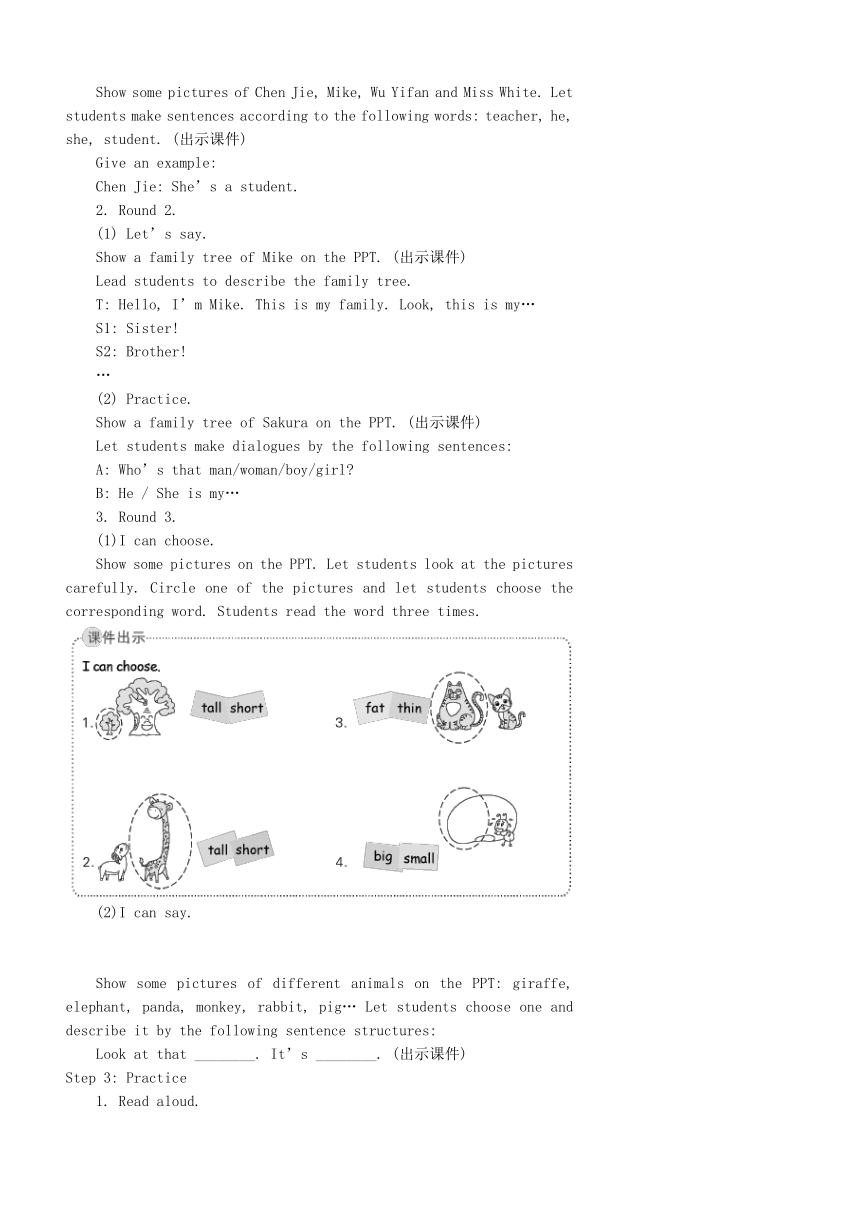人教版(PEP) 三年级下册Recycle1 第一课时教案
文档属性
| 名称 | 人教版(PEP) 三年级下册Recycle1 第一课时教案 |  | |
| 格式 | zip | ||
| 文件大小 | 227.0KB | ||
| 资源类型 | 教案 | ||
| 版本资源 | 人教版(PEP) | ||
| 科目 | 英语 | ||
| 更新时间 | 2021-04-12 20:02:46 | ||
图片预览



文档简介
Recycle
1
教材分析
本单元是复习巩固单元,专门针对第1~3单元所学习的核心句型和词汇设计的综合复习单元,由情景对话?歌曲歌谣?看图阅读以及找词游戏等不同形式的活动组成?本单元以情景教学为主,将前三个单元的核心句型和词汇串联起来,帮助学生在新的语境中将相对独立的知识点串成线?连成片?结成知识网络图,从而达到巩固?迁移和提高语言综合运用能力的目标
教学目标
知识目标:·复习询问他人籍贯或国籍的句型及其答语“—Where
are
you
from?
—I’m
from…”“He’s
from…”·复习询问远处陌生人的句型及其答语“—Who’s
that
man/woman?
—He’s/She’s
my…”“—Is
he/she
your…?
—No,
he/she
isn’t.”·复习描述动物特征的句型“It
is
(so)…”
“It
has…”·国家名:the
UK,
Canada,
the
USA,
China·人称代词:he,
she·家庭成员:grandfather(grandpa),
grandmother(grandma),
father(dad),
mother(mum),
brother,
sister·形容词:thin,
fat,
tall,
short,
long,
small,
big·其他:teacher,
student,
pupil,
man,
woman·元音字母a,
e,
i在单词中的短音发音/?/,
/e/,
/I/能力目标:·能够运用1~3单元所学词汇和句型介绍自己?家人以及朋友的籍贯或国籍等·能够运用1~3单元的词汇与句型询问和回答他人国籍或籍贯·能够运用1~3单元的词汇和句型描述动物的特征情感态度?文化意识?学习策略目标:·能够掌握复习?梳理和归纳的学习方法,注意发现所学语言规律,并能够将规律举一反三地运用?表达·在教师的引领下,逐步养成自主学习的习惯
课时安排
第一课时:
Page
32
&
Page
33第二课时:
Page
34
&
Page
35
The
first
period(第一课时)
Page
32
&
Page
33
?教学内容与目标
课时教学内容
课时教学目标
Page
32
·复习初次见面时的常用问候语以及向别人介绍自己朋友的句型·在教材创设的情景中复习询问并回答来自哪个国家的句型·培养学生的观察能力和模仿能力,进一步培养学生大胆开口?勇于在实际情景中运用语言的能力
Page
33
·复习有关动物的单词和描述动物的形容词·听懂?会唱与动物有关的歌谣
?教学重点
复习初次见面时的问候语?向别人介绍自己的朋友?询问并回答来自哪个国家等几个交际句型,要求做到听懂?会说?
?教学难点
熟练运用本课句型在情景中自然得体地进行会话?
?教学准备
1.预习《状元大课堂》《创优作业100分》《状元作业本》中本课时的相关内容?
2.
PPT课件?课文录音?视频?道具等?
?教学过程
Step
1:
Warm-up
&
Revision
1.
Greetings.
2.
Sing
a
song—At
the
zoo.
(播放课件)
3.
Sharp
eyes.
Show
the
words
of
the
last
three
units
on
the
PPT
one
by
one.
(出示课件)
T:
If
you
know
the
word,
you
can
stand
up
and
read
it.
One,
two,
three,
go!
Step
2:
Presentation
Memory
test.
1.
Round
1.
(1)
Students
say
the
names
of
the
nations.
Show
some
pictures
of
different
countries:
Big
Ben,
the
CN
Tower,
Golden
Gate
Bridge,
the
Great
Wall.
Let
students
say
the
names
of
the
nations.
(出示课件)
(2)
Guessing
game.
Show
some
animals
on
the
PPT:
panda,
beaver,
bald
eagle,
kangaroo.
Lead
students
to
guess
the
nations
of
the
animals
by
the
following
sentence
structure:
I’m
from…
(出示课件)
(3)
Can
you
say?
Show
some
pictures
of
Chen
Jie,
Mike,
Wu
Yifan
and
Miss
White.
Let
students
make
sentences
according
to
the
following
words:
teacher,
he,
she,
student.
(出示课件)
Give
an
example:
Chen
Jie:
She’s
a
student.
2.
Round
2.
(1)
Let’s
say.
Show
a
family
tree
of
Mike
on
the
PPT.
(出示课件)
Lead
students
to
describe
the
family
tree.
T:
Hello,
I’m
Mike.
This
is
my
family.
Look,
this
is
my…
S1:
Sister!
S2:
Brother!
…
(2)
Practice.
Show
a
family
tree
of
Sakura
on
the
PPT.
(出示课件)
Let
students
make
dialogues
by
the
following
sentences:
A:
Who’s
that
man/woman/boy/girl?
B:
He
/
She
is
my…
3.
Round
3.
(1)I
can
choose.
Show
some
pictures
on
the
PPT.
Let
students
look
at
the
pictures
carefully.
Circle
one
of
the
pictures
and
let
students
choose
the
corresponding
word.
Students
read
the
word
three
times.
(2)I
can
say.
Show
some
pictures
of
different
animals
on
the
PPT:
giraffe,
elephant,
panda,
monkey,
rabbit,
pig…
Let
students
choose
one
and
describe
it
by
the
following
sentence
structures:
Look
at
that
________.
It’s
________.
(出示课件)
Step
3:
Practice
1.
Read
aloud.
(1)
Watch
and
answer.
①Let
students
look
at
the
pictures
on
page
32
carefully.
(课件出示:教材P32
Read
aloud的图片)
Students
predict
the
main
ideas
of
the
dialogues.
Then
answer
the
questions.
Students
can
discuss
in
groups.
②The
teacher
plays
the
cartoon
for
the
first
time.
(播放课件)
Students
watch
the
cartoon
and
answer
the
questions.
T:
Where
is
John
from?
Ss:
He
is
from
the
USA.
T:
Who
is
the
tall
girl?
Ss:
Wang
Tong.
T:
Yes.
She’s
tall
and
she
likes
sports.
(2)
Read
and
act.
①Students
read
after
the
recording.
Pay
attention
to
the
pronunciation
and
the
intonation.
②Students
read
after
the
teacher.
Then
the
teacher
invites
some
students
to
act
as
little
teachers
to
lead
the
others
to
read.
③Practice
the
dialogues
in
groups.
Then
students
wear
the
headwears
to
act
out
the
dialogues.
2.
Listen
and
chant.
(1)
Let
students
look
at
the
picture.
(课件出示:教材P33
Listen
and
chant的图片)
T:
Look
at
that
baby
panda!
It’s…?
Ss:
It’s
fat.
T:
How
about
the
bird?
Ss:
It’s
small.
(2)
Watch
and
answer.
Students
watch
the
cartoon,
then
answer
the
questions.
(播放课件)
T:
Who
is
small
and
fast?
Ss:
The
bird!
T:
Who
is
a
little
bit
fat
and
has
a
short
tail?
Ss:
The
panda!
(3)
Students
read
after
the
recording
and
chant
in
groups.
Then
clap
their
hands
and
chant
together.
Step
4:
Consolidation
&
Extension
Match
and
read
aloud.
1.
Talk
about
the
animals.
(课件出示:教材P33
Match
and
read
aloud的图片)
Students
look
at
the
pictures
and
describe
the
animals.
S1:
Look
at
that
elephant.
It’s
fat.
It
has
a
long
nose.
S2:
Look
at
that
bird.
It’s
small.
…
2.
Read
and
match.
Let
students
read
the
sentences
aloud
and
match
them.
Students
read
together
to
check
the
answers.
3.
Make
a
new
chant.
Let
students
try
to
make
a
new
chant.
Give
an
example:
Little
monkey,
little
monkey.
You
are
small
and
fast.
Baby
elephant,
baby
elephant.
You
are
a
little
bit
fat.
?板书设计
?作业设计
1.
Practice
the
dialogues
and
sing
the
chant.
2.
Do
the
exercises.
(见“”系列丛书《创优作业100分》或《状元作业本》对应课时作业)
?教学反思
1.实施单元整体教学,把握单元教学目标的整体性,挖掘单元教学内容的整体性,设计单元教学过程的整体性,充分体现新课程教学理念?
2.复习活动设计多样化,较全面地兼顾到了各个单元的重点知识?
3.看图说话?口语交流?看图练习?唱歌等多种形式充分调动了学生的积极性,使学生在不知不觉中完成了复习任务,达到了较好的效果?
?Teaching
Contents
&
Teaching
Aims
Page
32
·Be
able
to
greet
others
and
introduce
their
friends
to
others.
·Review
the
sentence
structures
of
asking
and
answering
the
questions
about
nationality.
·Cultivate
students’
abilities
of
observation
and
imitation,
and
further
develop
students’
abilities
to
speak
boldly
and
use
the
language
in
the
real
situations.
Page
33
·Review
the
adjectives
that
describe
animals.
·Understand
and
sing
the
chant
about
animals.
?Teaching
Priorities
·Be
able
to
greet
and
introduce
friends
to
others,
ask
and
answer
the
questions
about
nationality.
?Teaching
Difficulties
·Use
the
sentence
structures
properly
in
the
real
situations.
?Teaching
Procedures
Teaching
Stages
Teacher’
s
Activities
Students’
Activities
Teaching
Purposes
Warm-up
&
Revision
1.
Greetings.2.
Sing
a
song—At
the
zoo.3.
Sharp
eyes.
1.
Greetings.2.
Sing
the
song.3.
Play
the
game.
Arouse
students’
learning
interest.
Help
students
review
the
words
that
they
have
learned.
Presentation
Memory
test.1.
Round
1.
(1)
Let
students
say
the
names
of
the
nations.(2)
Guessing
game.(3)
Can
you
say?
(1)
Say
the
names
of
the
nations
according
to
the
pictures.(2)
Guess
the
nations
of
the
animals.(3)
Describe
the
characters
by
using
the
sentence
structures
“He’s/She’s…”
Help
students
review
the
names
of
the
nations,
the
words
and
the
sentences:
Where
are
you
from?
I’m
from…
He’s/She’s…
2.
Round
2.(1)
Let’s
say.(2)
Practice.
(1)
Describe
the
family
tree.(2)
Make
dialogues
according
to
the
family
tree.
Help
students
review
the
words
about
the
family
members,
and
practice
the
sentences
to
introduce
the
family
members.
3.
Round
3.(1)I
can
choose.(2)I
can
say.
(1)
Look
at
the
pictures
carefully
and
choose
the
corresponding
word.
Read
the
word
three
times.(2)
Describe
the
animals
by
the
sentence
structures
“Look
at
that…
It’s…”
Help
students
review
the
adjectives
that
describe
the
animals
and
the
sentences
of
describing
the
animals.
Practice
1.
Read
aloud.(1)
Watch
and
answer.(2)
Read
and
act.
(1)
Look
at
the
pictures
and
predict
the
main
ideas
of
the
dialogues.
Watch
the
cartoon
and
answer
the
questions.(2)
Read
the
dialogues
after
the
recording
and
the
teacher
and
practice
in
groups.
Act
out
the
dialogues.
Help
students
to
get
the
overall
perception
of
the
text
and
the
useful
information.
Make
sure
students
read
the
dialogues
correctly
and
fluently.
2.
Listen
and
chant.Let
students
look
at
the
picture
and
watch
the
cartoon.
Ask
some
questions.
Look
at
the
picture,
discuss
and
talk
about
the
animals.
Watch
the
cartoon
and
answer
the
questions.
Read
and
learn
to
sing
the
chant.
Stimulate
students’
English
learning
interest.
Help
students
get
the
overall
perception
of
the
chant.
Consolidation
&
Extension
Match
and
read
aloud.1.
Talk
about
the
animals.2.
Read
and
match.3.
Make
a
new
chant.
1.
Look
at
the
pictures
and
describe
the
animals.
2.
Read
the
sentences
and
do
the
match.3.
Try
to
make
a
new
chant
and
share
it
in
class.
Cultivate
students’
divergent
thinking
ability.
Homework
1.
Practice
the
dialogues
and
sing
the
chant.2.
Do
the
exercises.
1
教材分析
本单元是复习巩固单元,专门针对第1~3单元所学习的核心句型和词汇设计的综合复习单元,由情景对话?歌曲歌谣?看图阅读以及找词游戏等不同形式的活动组成?本单元以情景教学为主,将前三个单元的核心句型和词汇串联起来,帮助学生在新的语境中将相对独立的知识点串成线?连成片?结成知识网络图,从而达到巩固?迁移和提高语言综合运用能力的目标
教学目标
知识目标:·复习询问他人籍贯或国籍的句型及其答语“—Where
are
you
from?
—I’m
from…”“He’s
from…”·复习询问远处陌生人的句型及其答语“—Who’s
that
man/woman?
—He’s/She’s
my…”“—Is
he/she
your…?
—No,
he/she
isn’t.”·复习描述动物特征的句型“It
is
(so)…”
“It
has…”·国家名:the
UK,
Canada,
the
USA,
China·人称代词:he,
she·家庭成员:grandfather(grandpa),
grandmother(grandma),
father(dad),
mother(mum),
brother,
sister·形容词:thin,
fat,
tall,
short,
long,
small,
big·其他:teacher,
student,
pupil,
man,
woman·元音字母a,
e,
i在单词中的短音发音/?/,
/e/,
/I/能力目标:·能够运用1~3单元所学词汇和句型介绍自己?家人以及朋友的籍贯或国籍等·能够运用1~3单元的词汇与句型询问和回答他人国籍或籍贯·能够运用1~3单元的词汇和句型描述动物的特征情感态度?文化意识?学习策略目标:·能够掌握复习?梳理和归纳的学习方法,注意发现所学语言规律,并能够将规律举一反三地运用?表达·在教师的引领下,逐步养成自主学习的习惯
课时安排
第一课时:
Page
32
&
Page
33第二课时:
Page
34
&
Page
35
The
first
period(第一课时)
Page
32
&
Page
33
?教学内容与目标
课时教学内容
课时教学目标
Page
32
·复习初次见面时的常用问候语以及向别人介绍自己朋友的句型·在教材创设的情景中复习询问并回答来自哪个国家的句型·培养学生的观察能力和模仿能力,进一步培养学生大胆开口?勇于在实际情景中运用语言的能力
Page
33
·复习有关动物的单词和描述动物的形容词·听懂?会唱与动物有关的歌谣
?教学重点
复习初次见面时的问候语?向别人介绍自己的朋友?询问并回答来自哪个国家等几个交际句型,要求做到听懂?会说?
?教学难点
熟练运用本课句型在情景中自然得体地进行会话?
?教学准备
1.预习《状元大课堂》《创优作业100分》《状元作业本》中本课时的相关内容?
2.
PPT课件?课文录音?视频?道具等?
?教学过程
Step
1:
Warm-up
&
Revision
1.
Greetings.
2.
Sing
a
song—At
the
zoo.
(播放课件)
3.
Sharp
eyes.
Show
the
words
of
the
last
three
units
on
the
PPT
one
by
one.
(出示课件)
T:
If
you
know
the
word,
you
can
stand
up
and
read
it.
One,
two,
three,
go!
Step
2:
Presentation
Memory
test.
1.
Round
1.
(1)
Students
say
the
names
of
the
nations.
Show
some
pictures
of
different
countries:
Big
Ben,
the
CN
Tower,
Golden
Gate
Bridge,
the
Great
Wall.
Let
students
say
the
names
of
the
nations.
(出示课件)
(2)
Guessing
game.
Show
some
animals
on
the
PPT:
panda,
beaver,
bald
eagle,
kangaroo.
Lead
students
to
guess
the
nations
of
the
animals
by
the
following
sentence
structure:
I’m
from…
(出示课件)
(3)
Can
you
say?
Show
some
pictures
of
Chen
Jie,
Mike,
Wu
Yifan
and
Miss
White.
Let
students
make
sentences
according
to
the
following
words:
teacher,
he,
she,
student.
(出示课件)
Give
an
example:
Chen
Jie:
She’s
a
student.
2.
Round
2.
(1)
Let’s
say.
Show
a
family
tree
of
Mike
on
the
PPT.
(出示课件)
Lead
students
to
describe
the
family
tree.
T:
Hello,
I’m
Mike.
This
is
my
family.
Look,
this
is
my…
S1:
Sister!
S2:
Brother!
…
(2)
Practice.
Show
a
family
tree
of
Sakura
on
the
PPT.
(出示课件)
Let
students
make
dialogues
by
the
following
sentences:
A:
Who’s
that
man/woman/boy/girl?
B:
He
/
She
is
my…
3.
Round
3.
(1)I
can
choose.
Show
some
pictures
on
the
PPT.
Let
students
look
at
the
pictures
carefully.
Circle
one
of
the
pictures
and
let
students
choose
the
corresponding
word.
Students
read
the
word
three
times.
(2)I
can
say.
Show
some
pictures
of
different
animals
on
the
PPT:
giraffe,
elephant,
panda,
monkey,
rabbit,
pig…
Let
students
choose
one
and
describe
it
by
the
following
sentence
structures:
Look
at
that
________.
It’s
________.
(出示课件)
Step
3:
Practice
1.
Read
aloud.
(1)
Watch
and
answer.
①Let
students
look
at
the
pictures
on
page
32
carefully.
(课件出示:教材P32
Read
aloud的图片)
Students
predict
the
main
ideas
of
the
dialogues.
Then
answer
the
questions.
Students
can
discuss
in
groups.
②The
teacher
plays
the
cartoon
for
the
first
time.
(播放课件)
Students
watch
the
cartoon
and
answer
the
questions.
T:
Where
is
John
from?
Ss:
He
is
from
the
USA.
T:
Who
is
the
tall
girl?
Ss:
Wang
Tong.
T:
Yes.
She’s
tall
and
she
likes
sports.
(2)
Read
and
act.
①Students
read
after
the
recording.
Pay
attention
to
the
pronunciation
and
the
intonation.
②Students
read
after
the
teacher.
Then
the
teacher
invites
some
students
to
act
as
little
teachers
to
lead
the
others
to
read.
③Practice
the
dialogues
in
groups.
Then
students
wear
the
headwears
to
act
out
the
dialogues.
2.
Listen
and
chant.
(1)
Let
students
look
at
the
picture.
(课件出示:教材P33
Listen
and
chant的图片)
T:
Look
at
that
baby
panda!
It’s…?
Ss:
It’s
fat.
T:
How
about
the
bird?
Ss:
It’s
small.
(2)
Watch
and
answer.
Students
watch
the
cartoon,
then
answer
the
questions.
(播放课件)
T:
Who
is
small
and
fast?
Ss:
The
bird!
T:
Who
is
a
little
bit
fat
and
has
a
short
tail?
Ss:
The
panda!
(3)
Students
read
after
the
recording
and
chant
in
groups.
Then
clap
their
hands
and
chant
together.
Step
4:
Consolidation
&
Extension
Match
and
read
aloud.
1.
Talk
about
the
animals.
(课件出示:教材P33
Match
and
read
aloud的图片)
Students
look
at
the
pictures
and
describe
the
animals.
S1:
Look
at
that
elephant.
It’s
fat.
It
has
a
long
nose.
S2:
Look
at
that
bird.
It’s
small.
…
2.
Read
and
match.
Let
students
read
the
sentences
aloud
and
match
them.
Students
read
together
to
check
the
answers.
3.
Make
a
new
chant.
Let
students
try
to
make
a
new
chant.
Give
an
example:
Little
monkey,
little
monkey.
You
are
small
and
fast.
Baby
elephant,
baby
elephant.
You
are
a
little
bit
fat.
?板书设计
?作业设计
1.
Practice
the
dialogues
and
sing
the
chant.
2.
Do
the
exercises.
(见“”系列丛书《创优作业100分》或《状元作业本》对应课时作业)
?教学反思
1.实施单元整体教学,把握单元教学目标的整体性,挖掘单元教学内容的整体性,设计单元教学过程的整体性,充分体现新课程教学理念?
2.复习活动设计多样化,较全面地兼顾到了各个单元的重点知识?
3.看图说话?口语交流?看图练习?唱歌等多种形式充分调动了学生的积极性,使学生在不知不觉中完成了复习任务,达到了较好的效果?
?Teaching
Contents
&
Teaching
Aims
Page
32
·Be
able
to
greet
others
and
introduce
their
friends
to
others.
·Review
the
sentence
structures
of
asking
and
answering
the
questions
about
nationality.
·Cultivate
students’
abilities
of
observation
and
imitation,
and
further
develop
students’
abilities
to
speak
boldly
and
use
the
language
in
the
real
situations.
Page
33
·Review
the
adjectives
that
describe
animals.
·Understand
and
sing
the
chant
about
animals.
?Teaching
Priorities
·Be
able
to
greet
and
introduce
friends
to
others,
ask
and
answer
the
questions
about
nationality.
?Teaching
Difficulties
·Use
the
sentence
structures
properly
in
the
real
situations.
?Teaching
Procedures
Teaching
Stages
Teacher’
s
Activities
Students’
Activities
Teaching
Purposes
Warm-up
&
Revision
1.
Greetings.2.
Sing
a
song—At
the
zoo.3.
Sharp
eyes.
1.
Greetings.2.
Sing
the
song.3.
Play
the
game.
Arouse
students’
learning
interest.
Help
students
review
the
words
that
they
have
learned.
Presentation
Memory
test.1.
Round
1.
(1)
Let
students
say
the
names
of
the
nations.(2)
Guessing
game.(3)
Can
you
say?
(1)
Say
the
names
of
the
nations
according
to
the
pictures.(2)
Guess
the
nations
of
the
animals.(3)
Describe
the
characters
by
using
the
sentence
structures
“He’s/She’s…”
Help
students
review
the
names
of
the
nations,
the
words
and
the
sentences:
Where
are
you
from?
I’m
from…
He’s/She’s…
2.
Round
2.(1)
Let’s
say.(2)
Practice.
(1)
Describe
the
family
tree.(2)
Make
dialogues
according
to
the
family
tree.
Help
students
review
the
words
about
the
family
members,
and
practice
the
sentences
to
introduce
the
family
members.
3.
Round
3.(1)I
can
choose.(2)I
can
say.
(1)
Look
at
the
pictures
carefully
and
choose
the
corresponding
word.
Read
the
word
three
times.(2)
Describe
the
animals
by
the
sentence
structures
“Look
at
that…
It’s…”
Help
students
review
the
adjectives
that
describe
the
animals
and
the
sentences
of
describing
the
animals.
Practice
1.
Read
aloud.(1)
Watch
and
answer.(2)
Read
and
act.
(1)
Look
at
the
pictures
and
predict
the
main
ideas
of
the
dialogues.
Watch
the
cartoon
and
answer
the
questions.(2)
Read
the
dialogues
after
the
recording
and
the
teacher
and
practice
in
groups.
Act
out
the
dialogues.
Help
students
to
get
the
overall
perception
of
the
text
and
the
useful
information.
Make
sure
students
read
the
dialogues
correctly
and
fluently.
2.
Listen
and
chant.Let
students
look
at
the
picture
and
watch
the
cartoon.
Ask
some
questions.
Look
at
the
picture,
discuss
and
talk
about
the
animals.
Watch
the
cartoon
and
answer
the
questions.
Read
and
learn
to
sing
the
chant.
Stimulate
students’
English
learning
interest.
Help
students
get
the
overall
perception
of
the
chant.
Consolidation
&
Extension
Match
and
read
aloud.1.
Talk
about
the
animals.2.
Read
and
match.3.
Make
a
new
chant.
1.
Look
at
the
pictures
and
describe
the
animals.
2.
Read
the
sentences
and
do
the
match.3.
Try
to
make
a
new
chant
and
share
it
in
class.
Cultivate
students’
divergent
thinking
ability.
Homework
1.
Practice
the
dialogues
and
sing
the
chant.2.
Do
the
exercises.
